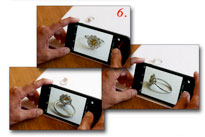Not just a pretty face
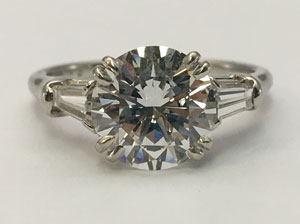 All appraisals should have photos of the jewelry. And that means not just one picture per piece, but several.
All appraisals should have photos of the jewelry. And that means not just one picture per piece, but several.
Photos provide important information that can be conveyed only in pictures—and they are surprisingly useful in the event of a loss.
Insurers rarely ask for photos of the jewelry. Many appraisals have none or have a low-resolution picture printed on the appraisal. If a single photo is included, it's usually a view like the one above, showing only the top of the ring—its pretty face.
But in the event of a total loss, is there enough information to provide a suitable replacement?
For jewelry of any complexity, a single view isn't sufficient. To create a replacement that matches the quality and styling details of the original, we need to see the ring from several angles.
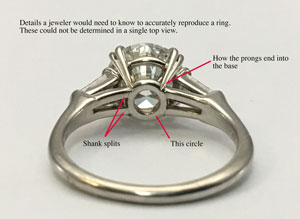 |
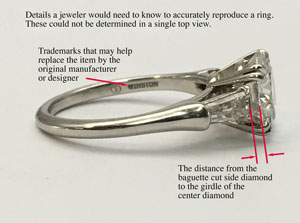 |
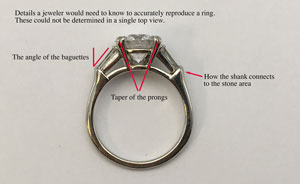 |
A more complete set of photos shows many details that a jeweler would need to accurately reproduce the ring.
Making a replacement – What CAD can do
Multiple photos not only reveal the jewelry's details but actually facilitate the creation of a replacement.
CAD-CAM (computer-aided design/computer-aided manufacturing) software is regularly used in jewelry design. The designer can create a piece from scratch, experiment with variations, and make adjustments for a client, all before anything is committed to metal.
The other thing CAD can do—and this is directly important to insurers—is design an accurate replacement for a piece of jewelry after a total loss. With photos showing multiple views of the original piece, such as those shown here, CAD software can make a precise three-dimensional rendering of the piece.
The rendering is then sent in the form of digital files to a 3D printer, mill or growing machine (the CAM part of the process), where the data are transformed into a 3D wax model. The wax model is used to cast the piece in the appropriate metal. A knowledgeable gemologist oversees the entire process, and the piece is soon ready for final finishing and stone setting.
What is a picture worth?
When there is a jewelry loss, insurers often wind up paying the full limit of liability simply because they don't have the photos that would make an accurate replacement possible.
Only a few years ago, getting jewelry photos that were sharp enough and close enough required a special camera for that purpose and some careful staging. Today, a smartphone, a sheet of white paper and some light will do a great job. The jewelry pictures in this article were taken with an iPhone 6sPlus.
Photos of the jewelry:
- Facilitate replacement after a total loss, saving overpayment of settlement.
- Deter fraud, as they show the condition of the jewelry when it was insured.
- Show complexity that can't be described in words.
- Show details usually left off the appraisal, such as workmanship and manufacturer's name and hallmark.
For a deeper look at how jewelry photos can prevent overpayment of settlements and thwart fraudulent claims, see our earlier issue on Every picture tells a story.
FOR AGENTS & UNDERWRITERS
Don't assume photos of jewelry are in the appraisal.
A picture printed on the appraisal is likely to be small and of low resolution, and it may be poorly printed. Such a picture is of little use. It is far better to have photos in jpg format.
It's best to have at least three photos, showing top, bottom and side views. The closer up, the better.
Photos are important in the event of a claim. Many insurance companies don't write agreed value, but they wind up writing a check for agreed value because they have no photos on which to create a replacement. More pictures make for a more successful settlement.
Offer to take photos of jewelry being insured, or recommend that the insured take pictures with her smart phone. Explain that having pictures from several angles is to her advantage in the event of a loss. And add the advice about turning the flash OFF.
FOR ADJUSTERS
When pricing a replacement, include any photos of the jewelry on file, as well as the appraisal description. (Do NOT include the valuation. The replacement house should be matching the quality of the jewelry, not its [possibly inflated] valuation.)
When submitting damaged jewelry for repair, Include photos from your file. A gemologist may see that the apparent damage was actually the original condition of the jewelry when it was insured.
©2000-2025, JCRS Inland Marine Solutions, Inc. All Rights Reserved. www.jcrs.com

